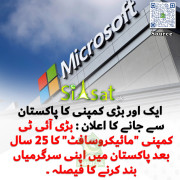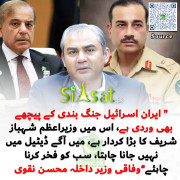Citizen X
(50k+ posts) بابائے فورم
After the death of Muhammad in 632 CE, the Muslim community found itself at a crossroads. With their Prophet gone, the early believers faced deep uncertainty: how could they maintain unity and fidelity to the divine message without their living guide? In Muhammad’s lifetime, obedience to him was emphasized, but it coexisted with questioning. Followers asked him for clarification, and the Qur'an itself preserves many moments of dialogue and inquiry. Muhammad often responded patiently, sometimes awaiting divine revelation to settle issues. Obedience was seen as loyalty to God's messenger, not as blind submission.
Once the Prophet passed away and a rapidly expanding empire with people of all backgrounds and languages entering into Islam the early Muslims found themselves at a crossroad. How could they maintain unity and fidelity to Allah's message with the Prophet to lead them. In his lifetime, obedience to him was unquestioned, but it coexisted with questioning and inquiry. The Quran itself preserves many such moments. For example
58:1- Indeed, Allah has heard the argument of the woman who pleaded with you ˹O Prophet˺ concerning her husband, and appealed to Allah. Allah has heard your exchange. Surely Allah is All-Hearing, All-Seeing.
This verse speaks about a woman coming to Muhammad with a personal grievance. Here, the Prophet is engaged in a dialogue, listening and responding to a question. It shows that asking questions and bringing concerns was part of the dynamic between him and his followers.
Obedience to the Prophet was seen as loyalty to him, not blind following and submission.
In the earliest centuries after Muhammad's passing, the study of hadith was not the rigid, absolutist discipline it is often perceived as today. It was a living, breathing field, shaped by scholars who approached transmitted reports with caution, scrutiny, and a profound sense of responsibility. Figures like Shuʿba, Ibn al-Mubarak, Yahya ibn Maʿin, and Ahmad ibn Hanbal understood that, even if it meant questioning reliable transmitters or rejecting popular narratives.
Yet not too long after Muhammad’s death, the situation shifted. The survival of the young Muslim empire demanded cohesion, and the idea of "Obey the Prophet" began to take on a heavier tone. During the reign of the Rashidun Caliphs, there was room for debate and independent reasoning — the companions of Muhammad often disagreed among themselves.
The transformation accelerated under the Umayyad dynasty. Faced with rebellions and political chaos, the rulers promoted the idea that obedience to religious and political authority was not only practical but divinely mandated. It was during this period that hadiths emphasizing loyalty to rulers and discouraging rebellion circulated widely. Disobedience was framed not just as political treason but as a religious failing, subtly shifting the cultural attitude toward unquestioning loyalty to both state and religion.
The Abbasid Caliphate deepened this transformation by constructing a vast bureaucratic empire that needed ideological tools to control its diverse population. Scholars began systematically compiling the sayings and actions of Muhammad. This marked a critical turning point: obeying the Prophet no longer just meant following his major teachings; it evolved into accepting all authentic hadith and his example without question.
Scholars like Imam al-Shafi'i formalized the authority of hadith, raising the Prophet’s words and deeds to a status second only to the Qur'an itself. Muhammad was made to seen as the perfect human model, whose every action, no matter how small, carried divine significance. Thus, questioning an authentic hadith became synonymous with questioning divine will. The Quranic phrase "Obey the Prophet" began to mean accept all authentic hadith and his example unquestioningly, hardened into an unequivocal rule: once a hadith was judged authentic, it had to be accepted without hesitation or critique.
Although there is lack of evidence but it is widely attributed that Shafi'i said "The hadith does not need the Quran but the Quran needs the hadith"
This rigid view of hadith study contrasted sharply with the critical spirit of earlier scholars like Yahya ibn Maʿin, Abu Hatim al-Razi, Ibn Hibban, and al-Daraqutni, who exemplified intellectual rigor and caution. For instance, Yahya ibn Maʿin, though he often rated narrators as trustworthy, would flag subtle flaws in their reports, understanding that a sound isnad (chain of transmission) did not guarantee sound content. Similarly, Abu Hatim al-Razi rejected certain hadiths based on their content, even if the isnad was intact, such as a report about the Prophet wearing two green cloaks in battle that contradicted historical knowledge. Al-Daraqutni’s critical approach even extended to Sahih Bukhari and Sahih Muslim, highlighting inconsistencies in content despite strong isnads.
Despite these early examples of critical scholarship, the ethos of "Obey the Prophet" grew more rigid over time. By the Abbasid era, this shift toward unquestioning submission was cemented in both scholarly and popular spheres. Scholars and religious leaders were expected to transmit knowledge without challenging it, while the masses adopted a simplified view of Islam: God speaks, the Prophet acts, and we follow. This unbroken chain of obedience became the new norm, where dissent or questioning was associated with heresy, division, or even political rebellion. Rulers and religious authorities had a vested interest in promoting this attitude, as it guaranteed stability and control.
By the 9th and 10th centuries, Sunni orthodoxy had crystallized around this view. Obeying the Prophet no longer carried the dynamic sense of dialogue and living faith that had characterized the Prophet’s lifetime. It had become a call to unconditional submission to the recorded words and deeds attributed to Muhammad. Faithfulness was measured not by one's willingness to ask questions, but by one's readiness to accept without hesitation.
This transformation reshaped Islamic thought, practice, and political life for centuries. To obey became synonymous with belief, and to question was to risk everything. The rationalist movements within Islam — the Muʿtazilites and early Maturidis — had fought to preserve the role of critical reason, insisting that not every text should be accepted uncritically. But by the 10th and 11th centuries, these movements were politically defeated and marginalized. Sunni orthodoxy, emphasizing preservation over reevaluation, reigned supreme.
The legacy of this shift intensified in the face of European colonialism. Muslim societies, reeling from humiliation and defeat, clung even tighter to the idea of a "pure" and "authentic" Islam. The literalist interpretations promoted by early Salafism and thinkers like Ibn Taymiyya stripped away the intellectual complexity once present in hadith study. As mass literacy and printing revolutions spread in the 19th and 20th centuries, hadiths were distilled into simple formulas for public consumption: Sahih meant true, Da’if meant false. Centuries of scholarly nuance, where even sound isnads were questioned and content weighed against reason, history, and ethics, were reduced to black-and-white thinking.
Thus, the path from the vibrant, questioning spirit of early hadith criticism to the rigid absolutism of modern orthodoxy was shaped by theological developments, political needs, colonial trauma, and the demands of mass culture. In the beginning, scholars of hadith were critics, seeking truth and willing to challenge even the most trusted chains. Today, for many, it means rigid loyalty to text, where questioning itself is often seen as a betrayal.
The ripple effects of this transformation continues to shape Islamic thought and practice today, where to obey is to believe, and to question is to risk not just one’s intellectual integrity but one’s very place within the community. What began as a careful, dynamic engagement with the Prophet has evolved into a call for unquestioning submission — a reflection of how religious authority can shift over time, from critical inquiry to absolute obedience.
Once the Prophet passed away and a rapidly expanding empire with people of all backgrounds and languages entering into Islam the early Muslims found themselves at a crossroad. How could they maintain unity and fidelity to Allah's message with the Prophet to lead them. In his lifetime, obedience to him was unquestioned, but it coexisted with questioning and inquiry. The Quran itself preserves many such moments. For example
58:1- Indeed, Allah has heard the argument of the woman who pleaded with you ˹O Prophet˺ concerning her husband, and appealed to Allah. Allah has heard your exchange. Surely Allah is All-Hearing, All-Seeing.
This verse speaks about a woman coming to Muhammad with a personal grievance. Here, the Prophet is engaged in a dialogue, listening and responding to a question. It shows that asking questions and bringing concerns was part of the dynamic between him and his followers.
Obedience to the Prophet was seen as loyalty to him, not blind following and submission.
In the earliest centuries after Muhammad's passing, the study of hadith was not the rigid, absolutist discipline it is often perceived as today. It was a living, breathing field, shaped by scholars who approached transmitted reports with caution, scrutiny, and a profound sense of responsibility. Figures like Shuʿba, Ibn al-Mubarak, Yahya ibn Maʿin, and Ahmad ibn Hanbal understood that, even if it meant questioning reliable transmitters or rejecting popular narratives.
Yet not too long after Muhammad’s death, the situation shifted. The survival of the young Muslim empire demanded cohesion, and the idea of "Obey the Prophet" began to take on a heavier tone. During the reign of the Rashidun Caliphs, there was room for debate and independent reasoning — the companions of Muhammad often disagreed among themselves.
The transformation accelerated under the Umayyad dynasty. Faced with rebellions and political chaos, the rulers promoted the idea that obedience to religious and political authority was not only practical but divinely mandated. It was during this period that hadiths emphasizing loyalty to rulers and discouraging rebellion circulated widely. Disobedience was framed not just as political treason but as a religious failing, subtly shifting the cultural attitude toward unquestioning loyalty to both state and religion.
The Abbasid Caliphate deepened this transformation by constructing a vast bureaucratic empire that needed ideological tools to control its diverse population. Scholars began systematically compiling the sayings and actions of Muhammad. This marked a critical turning point: obeying the Prophet no longer just meant following his major teachings; it evolved into accepting all authentic hadith and his example without question.
Scholars like Imam al-Shafi'i formalized the authority of hadith, raising the Prophet’s words and deeds to a status second only to the Qur'an itself. Muhammad was made to seen as the perfect human model, whose every action, no matter how small, carried divine significance. Thus, questioning an authentic hadith became synonymous with questioning divine will. The Quranic phrase "Obey the Prophet" began to mean accept all authentic hadith and his example unquestioningly, hardened into an unequivocal rule: once a hadith was judged authentic, it had to be accepted without hesitation or critique.
Although there is lack of evidence but it is widely attributed that Shafi'i said "The hadith does not need the Quran but the Quran needs the hadith"
This rigid view of hadith study contrasted sharply with the critical spirit of earlier scholars like Yahya ibn Maʿin, Abu Hatim al-Razi, Ibn Hibban, and al-Daraqutni, who exemplified intellectual rigor and caution. For instance, Yahya ibn Maʿin, though he often rated narrators as trustworthy, would flag subtle flaws in their reports, understanding that a sound isnad (chain of transmission) did not guarantee sound content. Similarly, Abu Hatim al-Razi rejected certain hadiths based on their content, even if the isnad was intact, such as a report about the Prophet wearing two green cloaks in battle that contradicted historical knowledge. Al-Daraqutni’s critical approach even extended to Sahih Bukhari and Sahih Muslim, highlighting inconsistencies in content despite strong isnads.
Despite these early examples of critical scholarship, the ethos of "Obey the Prophet" grew more rigid over time. By the Abbasid era, this shift toward unquestioning submission was cemented in both scholarly and popular spheres. Scholars and religious leaders were expected to transmit knowledge without challenging it, while the masses adopted a simplified view of Islam: God speaks, the Prophet acts, and we follow. This unbroken chain of obedience became the new norm, where dissent or questioning was associated with heresy, division, or even political rebellion. Rulers and religious authorities had a vested interest in promoting this attitude, as it guaranteed stability and control.
By the 9th and 10th centuries, Sunni orthodoxy had crystallized around this view. Obeying the Prophet no longer carried the dynamic sense of dialogue and living faith that had characterized the Prophet’s lifetime. It had become a call to unconditional submission to the recorded words and deeds attributed to Muhammad. Faithfulness was measured not by one's willingness to ask questions, but by one's readiness to accept without hesitation.
This transformation reshaped Islamic thought, practice, and political life for centuries. To obey became synonymous with belief, and to question was to risk everything. The rationalist movements within Islam — the Muʿtazilites and early Maturidis — had fought to preserve the role of critical reason, insisting that not every text should be accepted uncritically. But by the 10th and 11th centuries, these movements were politically defeated and marginalized. Sunni orthodoxy, emphasizing preservation over reevaluation, reigned supreme.
The legacy of this shift intensified in the face of European colonialism. Muslim societies, reeling from humiliation and defeat, clung even tighter to the idea of a "pure" and "authentic" Islam. The literalist interpretations promoted by early Salafism and thinkers like Ibn Taymiyya stripped away the intellectual complexity once present in hadith study. As mass literacy and printing revolutions spread in the 19th and 20th centuries, hadiths were distilled into simple formulas for public consumption: Sahih meant true, Da’if meant false. Centuries of scholarly nuance, where even sound isnads were questioned and content weighed against reason, history, and ethics, were reduced to black-and-white thinking.
Thus, the path from the vibrant, questioning spirit of early hadith criticism to the rigid absolutism of modern orthodoxy was shaped by theological developments, political needs, colonial trauma, and the demands of mass culture. In the beginning, scholars of hadith were critics, seeking truth and willing to challenge even the most trusted chains. Today, for many, it means rigid loyalty to text, where questioning itself is often seen as a betrayal.
The ripple effects of this transformation continues to shape Islamic thought and practice today, where to obey is to believe, and to question is to risk not just one’s intellectual integrity but one’s very place within the community. What began as a careful, dynamic engagement with the Prophet has evolved into a call for unquestioning submission — a reflection of how religious authority can shift over time, from critical inquiry to absolute obedience.


























